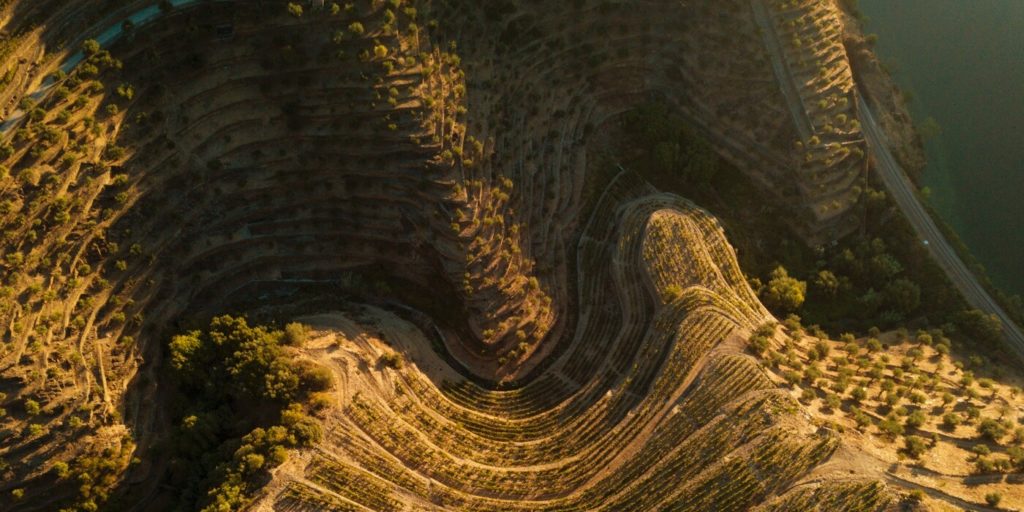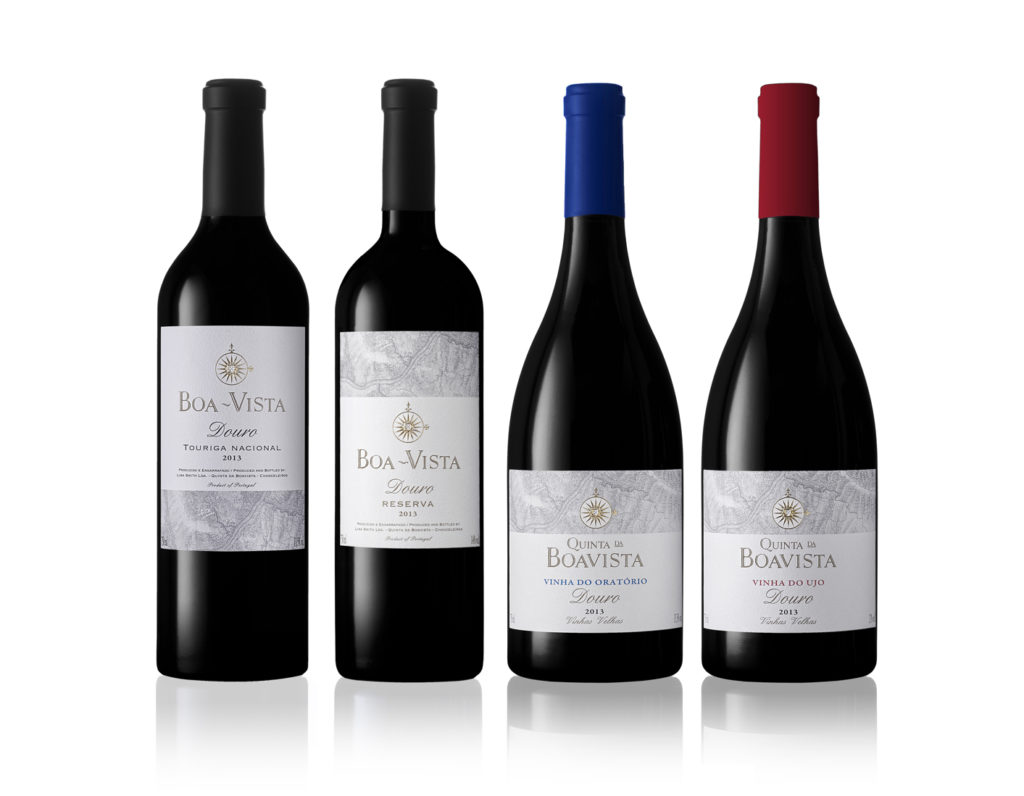The Douro has long been known for its fortified Port wines, but it is increasingly carving a reputation in the world of fine wine for its characterful (unfortified) red wines. The acquisition of Quinta da Boavista by Sogevinus in June 2020 was very much a sign of how premium red wines of the Douro are on the up. I had the chance last week to explore the estate and its wines ‘virtually’ over a video interview with winemaker Carla Tiago.
At the heart of Quinta da Boavista is its stunning vineyard estate which winds around different hillsides by the Douro river. With 36 hectares of vines, they are all planted facing different aspects, on different slopes and with totally different formations and vine ages… The oldest vines (over 80 years old) are planted as single vine rows using the traditional socalcos stone walls to support them, while the ‘middle-aged’ vines are planted in terraces with three or four rows of vines. The ‘new’ vines which have been planted on the property are planted as single variety vineyards — with Touriga Nacional, Touriga Franca and Tinta Cão. It’s a complex terroir to say the least!
At to that that most of the old and middle-aged vines are planted in field blends, and Carla and the viticulture team have quite a task to manage when it comes to choosing when to harvest. “It’s difficult with the field blends because you have to pick them all at the same time, and all the grapes have different times of maturation and so finding the right time to harvest is quite a challenge! But that’s what also makes it quite interesting,” Carla explained, adding that they do a bunch selection in the winery when the grapes come in if there are any over or underripe bunches. “In these field blends, we don’t know exactly what varieties we have and that’s part of the charm of the wines!”

I couldn’t agree more. I think what makes Douro red wines so unique is the natural complexity you get not only from the irrepressible terroir but also the unique grape varieties and complexity of these field blends and old vines. The classic Douro grape varieties (Touriga Nacional, Touriga Franca, Tinta Cão, Tinto Roriz) are rather well defined in terms of adding more spice, flesh, acid or tannin, but the complexity of these wines isn’t only in these different varieties but also the wealth of different genetic material within the same variety too. As Carla explained, Touriga Nacional for example, being one of the oldest grape varieties in the region, has a far greater genetic diversity than Touriga Franca, which is a relatively new grape variety and therefore often taken from the same clone.
All of this has resulted in an interesting year of discovery for Carla and an ongoing voyage to get to grips with the intricacies of the Quinta. Working with consultant winemaker Jean-Claude Berrouet (of Petrus fame), they are keen to keep the oak influence down and let the fruit character and terroir identity of the wines come through. “We have been using just 25% new oak so that we don’t have too much of that character coming through,” she explains.
Although Carla has been making wines in the Douro for several, she admits that the still wines of the Douro are still in their youth compared the region’s famed Port wines which have been made for over four centuries: “We’ve really only been making fine wine in the Douro for the past few years — perhaps 30 years ago were the first fine still wines. So every harvest is a new learning experience and we are always full of ideas on what to try and experiment with next!”
The wines of Quinta da Boavista do, however, stand out already for their incredibly Douro identity and personality. The Reserva offers an excellent overview of how the estate expresses both power and finesse — with bold, rich flavours and firm yet fine-grained tannins with tension on the finish. It’s an ideal wine to explore the potential of Douro blends.
Where the wines really sing though are in the two single parcel wines, Vinha da Oratório and Vinha do Ujo, which show how a single parcel can have a completely different personality to another. Oratório is more complex, grippy and bold with rich notes of ripe plum and strawberry jam as well as top notes of cedar, violet and exotic spice; whereas Ujo is a more elegant wine with perfumed notes of wild flowers and juicy red fruits, with a graphite-like tension and freshness the finish.
“Oratório means a place where you pray,” explains Carla, “and is named after the huge walls of schist on that plot. This wine faces east and has sun in the morning, but it is in the shadows in the afternoon. Whereas Ujo is north-facing and is less exposed than Oratório, which you can find in the glass. Oratório is more jammy and spicy, whereas Ujo is more floral, balsamic and fresh. They are quite different for this exposure, but they are also different because of the grapes. Ujo, for example, has more Rufete in the blend — and I think this freshness also comes from these grapes.”
Both the single lot wines were 2017 vintage, and certainly wines that could age well for over a decade or two. Tasting the Douro Reserva, Carla shared a 2016 and 2015 vintage — both of which were also lively and vivacious. “I tasted 2013 recently and it still maintains this fruitiness and freshness. I think the wines live the vines can have a really good, long life!”
I for one am really looking forward to continuing tasting these Quinta da Boavista wines as they age, and follow the Douro’s exciting red wine path into the future.

Interview with Quinta da Boavista winemaker Carla Tiago
Quinta da Boavista wine tasting notes

Quinta da Boavista Reserva 2017
The current release of the Reserva label is, as with the other Reserva wines, made from a blend of Touriga Nacional, Touriga Franca, Tinto Cão and a blend of old vines in a field blend. 2017 was a warm and dry vintage and this wine has a rich fruit profile with firm but approachable tannins and lingering notes of dark chocolate and pepper.
Quinta da Boavista Reserva 2016
Coming from a very good ‘classic’ vintage in the Douro, this vintage is showing really nicely right now with delicate floral notes rising above the ripe red and black forest fruit. It is fleshy and fresh in the palate with a spicy spine of tannin and vein of acidity keeping it in place. Notes of sage and fennel give it a complex finish, and, although this is really enjoyable now, this is certainly a wine that will age wonderfully.
Quinta da Boavista Reserva 2015
2015 was a fresher year in the Douro and the Reserva 2015 has a fresh, quite lively finish which plays off of the riper, plum notes and cedar that shows through in the palate. It is tasting beautifully right now and certainly at a great time to drink. Toastier notes linger on the finish.
Quinta da Boavista Vinha da Oratório 2017
The first of Quinta da Boavista’s two single parcel wines is Oratório which is a complex, rich and bold wine with a grippy texture and fine tannin on the long finish. With rich notes of plum and strawberry jam along with violet, exotic spice and cedar, it is a layered, mouthwatering wine that is bold in the nose but chiselled on the palate. Gorgeous now and certainly one that will age really well.
Quinta da Boavista Vinha do Ujo 2017
Coming from a single parcel of really old vines planted in a field blend, this is the most elegant and freshest of the line up which Carla puts down to potentially having more Rufete in the blend and being on a cooler, north-facing plot. It is abounding with floral perfume and has lots of bright, juicy red fruit notes with refreshing, spicy finish. An elegant yet complex Douro red with subtle layers of wildflowers, graphite and cherries.

